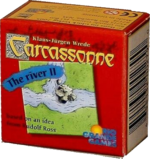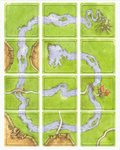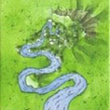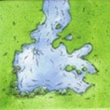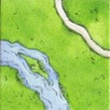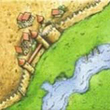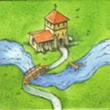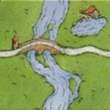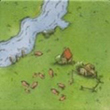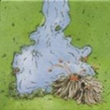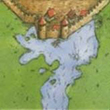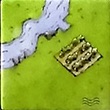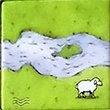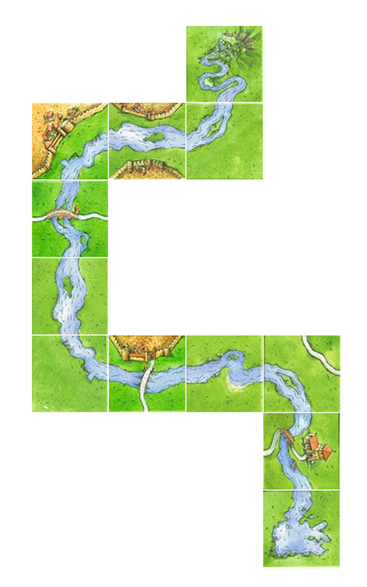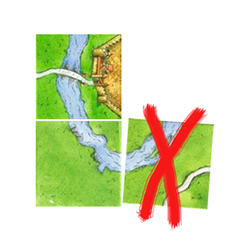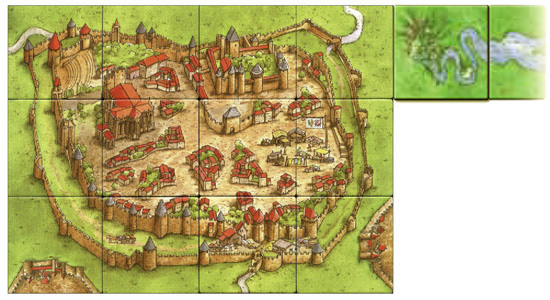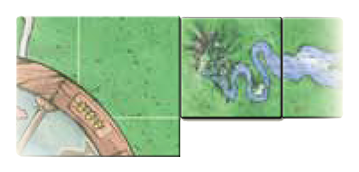Rzeka (1. edycja)
 |
You are reading the rules for this tile design. |
 | Read the following rules if your tiles look like this. |  |
| If your tiles have a different design, then choose a game from Spin-offs. |  |
General info and comments
 Expansion symbol River II |
 Expansion symbol for 2014 River version |
There are two River Expansions:
- The River (commonly known as River I) was originally released by Hans im Glück in 2001. [1]
- The River II was originally released by Hans im Glück in 2005, and later bundled in the major expansion
 Hrabia, Król i Rzeka in 2008.
Hrabia, Król i Rzeka in 2008.
The ![]() Games Quarterly #11 expansion from 2006 includes 2 river tiles that can be combined with any river expansion. One of these tiles is a new river source with a road. It can replace the one included in other rivers and help create smaller farms around the river.
Games Quarterly #11 expansion from 2006 includes 2 river tiles that can be combined with any river expansion. One of these tiles is a new river source with a road. It can replace the one included in other rivers and help create smaller farms around the river.
In 2014, HiG's ![]() Big Box 5 included a version of River I (sometimes referred to as River III) with some minor additions that tied in with
Big Box 5 included a version of River I (sometimes referred to as River III) with some minor additions that tied in with ![]() Owce i wzgórza.
Owce i wzgórza.
Contents
- 12 new land tiles (The River I) - providing a linear river configuration.
- 12 new land tiles (The River II) - providing a forked river layout.
- 12 new land tiles (The River III) - providing the same layout as River I and some extra features.
- 2 new river tiles (Games Quarterly #11) - providing an alternative river source.
Common features found on river tiles: [2]
River II shows river segments as well as familiar features such as cities, cloisters, roads, and fields plus a river fork, an inn (tie-in with ![]() Karczmy i katedry), a pig-herd (tie-in with
Karczmy i katedry), a pig-herd (tie-in with ![]() Kupcy i budowniczowie) and a volcano (tie-in with
Kupcy i budowniczowie) and a volcano (tie-in with ![]() Księżniczka i Smok.)
Księżniczka i Smok.)
Particular features found in River II:
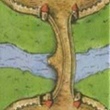
|
A bridge that does not split the fields and creates one single city [5] |
River III has the same layout of river and claimable features as River I, thus it is considered the same expansion. However, this version also adds features to mesh with the ![]() Owce i wzgórza expansion – there are 2 tiles with a sheep and 2 tiles with a vineyard. Additionally, the backs of the river tiles in this version are the light gray of standard tiles rather than the dark gray of starting tiles, and there is a new expansion symbol on the front.
Owce i wzgórza expansion – there are 2 tiles with a sheep and 2 tiles with a vineyard. Additionally, the backs of the river tiles in this version are the light gray of standard tiles rather than the dark gray of starting tiles, and there is a new expansion symbol on the front.
Particular features found in River III:
Games Quarterly #11 provides a new river source with a road ending at a small cottage. The road splits the farm surrounding the river source:
Rules
Preparation
The original starting tile is not used. [6] [7] [8]
Separate the spring tile and lake tile from the others. Place the spring tile in the middle of the table, and set the lake tile to the side for now. The other ten tiles are shuffled and placed face down into a stack. [9] [10]
If playing with River II, the fork tile should be set aside along with the source and lake tiles. The fork tile is placed first (after the source tile) by the first player.
Placing a tile
The players take turns placing tiles [11] [12] When the river is finished, the lake tile is placed, and the game continues with the remaining tiles.
If playing with River II, the first player places the fork. [13] [12] After this, each player on his or her turn places a tile either on left or right branches of the river. [14] The volcano tile is placed last. The player who places the volcano may not deploy a follower to this tile, but should place the dragon on the tile instead. [15] The player may therefore take another tile immediately, [16] thus beginning the normal game. The river tiles can be placed as the player wishes, except for two exceptions: no 180° turns are allowed, and the two river branches must not be connected.
Important: A U-turn with the river tiles is not possible. This means that a 180° turn is not allowed, as it may lead to difficulties in placing all the tiles.[17]
Deploying a follower
When a player places a river tile, he or she may deploy a follower using the normal rules for placing a follower. [18] No follower can be deployed to the river itself.
Scoring
River feature itself cannot be scored. All other features on river tiles are scored as usual. River segments separate farms.
Note on River II special features
If you don't possess the relevant expansions, the inn, volcano, pig-herd, vineyards and sheep tiles have no particular significance. [19]
The pig-herd tile earns the farmer who owns this farm an extra 1 point per city. If a player has the pig-herd and a pig (from the ![]() Kupcy i budowniczowie expansion), he or she receives an additional 2 points per city. [20] [21] [22] [23] [24]
Kupcy i budowniczowie expansion), he or she receives an additional 2 points per city. [20] [21] [22] [23] [24]
Other expansions
 Hrabia Carcassonne
Hrabia Carcassonne
The question of how to combine the various “starting” expansions of Carcassonne is a longstanding one, and HiG has changed its mind several times.
The original rules for ![]() Hrabia Carcassonne included the following clarification: “If the river is being used, then the spring tile should be placed next, and in such a way that the river leads away from the city.” Yet the rules still said that it was probably better not to use the expansions together, and this was the only piece of advice to make it into the introductory paragraph of its rules in
Hrabia Carcassonne included the following clarification: “If the river is being used, then the spring tile should be placed next, and in such a way that the river leads away from the city.” Yet the rules still said that it was probably better not to use the expansions together, and this was the only piece of advice to make it into the introductory paragraph of its rules in ![]() Hrabia, Król i Rzeka: “It is not recommended to combine
Hrabia, Król i Rzeka: “It is not recommended to combine ![]() Hrabia Carcassonne and any River expansion(s), as situations may arise in which it is impossible to place tiles properly.”
Hrabia Carcassonne and any River expansion(s), as situations may arise in which it is impossible to place tiles properly.”
The same rules by ZMG include the following paragraph: "The river spring must begin at one of the corners of the City of Carcassonne. The players should place the river tiles so that the river flows away from the City of Carcassonne so as to avoid placement problems. Again, combining The Count of Carcassonne and The River I or The River II is not recommended."
As indicated above, this is no longer the recommended approach. Instead, one should always remember the rule from the basic game: “In the rare case that a tile cannot be placed anywhere, it is removed from the game, and the player draws another.” If the river winds around the City of Carcassonne in such a way that you cannot place the next tile (river or otherwise), the tile should be placed to one side, and another drawn. An interesting corollary of this is that the river does not have to be finished: if it is impossible to do so, you do not have to place the final lake tile, and a permanent gap in the playing field might arise (which could, of course, subsequently be filled by an abbey from the ![]() Opactwo i burmistrz expansion.)
Opactwo i burmistrz expansion.)
This clearly has consequences beyond combining the two expansions mentioned. Though the rules still say that U-turns are not allowed, resolving such issues is now much more straightforward—no more need to defenestrate players who insist on making awkward tile placements. And it helps considerably in establishing what a game of Mega-Carcassonne should look like.
Of course, some people will object that this rule destroys the aesthetics of the playing field. They might be right, and they are free to adopt a house rule which is more comfortable to them. But for the rules lawyers among us, this rule is an important development.
 Koło Fortuny
Koło Fortuny
![]() Rzeka and
Rzeka and ![]() Koło Fortuny expansions may be used together. In this case, the Wheel of Fortune board is first placed in the middle of the table. Then, the river source is placed so that the river will flow away from the Wheel of Fortune board. Place the river tiles and lake (mouth) according to the normal River rules. Once the lake (river mouth) has been placed, play proceeds according to normal Carcassonne rules.
Koło Fortuny expansions may be used together. In this case, the Wheel of Fortune board is first placed in the middle of the table. Then, the river source is placed so that the river will flow away from the Wheel of Fortune board. Place the river tiles and lake (mouth) according to the normal River rules. Once the lake (river mouth) has been placed, play proceeds according to normal Carcassonne rules.
 Owce i wzgórza with River III
Owce i wzgórza with River III
The sheep depicted on the river tiles are used with the ![]() Owce i wzgórza expansion. When a player performs a Gather the Flock action, the sheep depicted on the fields of these river tiles are to be counted and scored along with the Sheep tokens. These depicted sheep are permanent and may be scored multiple times during a game.
Owce i wzgórza expansion. When a player performs a Gather the Flock action, the sheep depicted on the fields of these river tiles are to be counted and scored along with the Sheep tokens. These depicted sheep are permanent and may be scored multiple times during a game.
The vineyards depicted on the river tiles are used with the ![]() Owce i wzgórza expansion and add to cloister scoring according to the normal vineyard rules.
Owce i wzgórza expansion and add to cloister scoring according to the normal vineyard rules.
When playing without the ![]() Owce i wzgórza expansion, the depicted sheep and vineyards have no function.
Owce i wzgórza expansion, the depicted sheep and vineyards have no function.
House Rules
House Rules for River I/III
- Ban all river U-turns to prevent problems with subsequent placement.
- You are not permitted to lay down any meeples until the entire river is down. (Thanks to metoth)
- Once the river is complete, it may be moved to the center of the playing area. (Thanks to Joff)
- Instead of starting with the spring and setting aside the lake, put all of the river pieces into the bag. In this way the river can be any size and there is usually more then one option for placing a river tile. (Thanks to DavidP)
- Mix the original starting tile (without a river) in with the river tiles. If it is drawn then it acts like a 'bonus' tile that can be placed anywhere. (Thanks to RationalLemming)
- Lay the river in reverse order, from lake to spring. No real advantage, but might be more desirable, when playing the Count expansion, to have the lake near the City of Carcassonne for purely aesthetic reasons. (Thanks to Scott)
House Rules for River II
- Play the fork of the river first, and lay the spring last. The lakes are mixed in with the other river tiles. (Thanks to Joff)
- Rather than discarding the second fork (from The River II and
 Hrabia, Król i Rzeka,) mix it in with the other river tiles and place it normally when it is drawn. (Thanks to Scott)
Hrabia, Król i Rzeka,) mix it in with the other river tiles and place it normally when it is drawn. (Thanks to Scott) - Pig-herds do not score a bonus. (Thanks to Joff)
- Play both rivers backwards starting with the city/lake. This is more realistic because you then get two springs producing rivers that join and flow ‘down’ to a lake. Discard two lakes—the plain one from River I and the volcano. To set up, place the lake tile, put one spring tile aside as a final ending tile, and then split the balance of the river tiles into two stacks. The junction tile is shuffled into stack 1 and the other spring into stack 2. Then the stack 1 is placed on stack 2—so that the junction will be drawn sometime before the spring. If playing with
 Hrabia Carcassonne, place the city/lake so that it completes one of the small cities around Carcassonne. (Thanks to dwhitworth)
Hrabia Carcassonne, place the city/lake so that it completes one of the small cities around Carcassonne. (Thanks to dwhitworth) - Select only one lake tile and use two spring tiles. Lay the river in reverse order. The fork can be placed randomly, or at some predetermined point. The end result is two rivers flowing into one which then flows into a lake. (Thanks to Scott)
- Start from the fork, playing tiles on all three branches. Play the spring and lake tiles at the end, or mix two of the three with the rest of the river before play to have two of the three branches end randomly. (Thanks to Scott)
- Play with two forks and a straight river between them. The ends (two lakes, a spring and a volcano) then come out randomly. Makes for a big river, but with 300 or so tiles it works. (Thanks to revolushn)
Tile Distribution
River I (Original 2001 River version)
River II
River III (2014 River I version)
Games Quarterly #11
Przypisy
W celu zapoznania się z objeśnieniami ikon oraz licencjami odwiedź: Ikony.
- ↑
 The idea was based on a design by game designer Rudolf Ross.
The idea was based on a design by game designer Rudolf Ross.
- ↑
 Officially, the field goes around the spring and the lake, creating a connected farm.
Officially, the field goes around the spring and the lake, creating a connected farm.
 This has been incorporated in the RGG edition of the
This has been incorporated in the RGG edition of the  Big Box 1, which includes The River (the HiG edition does not) and states that “The field space on the lake and spring tiles wraps around those features.”
Big Box 1, which includes The River (the HiG edition does not) and states that “The field space on the lake and spring tiles wraps around those features.”
- ↑
 In the ZMG rules, this is referred to as the river source. (12/2014)
In the ZMG rules, this is referred to as the river source. (12/2014)
- ↑
 In the ZMG rules, this is referred to as the river mouth, although in New Carcassonne this has gone back to being the lake. (12/2014)
In the ZMG rules, this is referred to as the river mouth, although in New Carcassonne this has gone back to being the lake. (12/2014)
- ↑
 The city bridge does not separate field segments. Only the river separates the field segments on this tile. Thus, there are 2 field segments on this tile. [This is logical, as similar city bridges in other expansions such as
The city bridge does not separate field segments. Only the river separates the field segments on this tile. Thus, there are 2 field segments on this tile. [This is logical, as similar city bridges in other expansions such as  Opactwo i burmistrz do not divide the city underneath. – Chris O.] (1/2013)
Opactwo i burmistrz do not divide the city underneath. – Chris O.] (1/2013)
- ↑
 This is an addition to the
This is an addition to the  Hrabia, Król i Rzeka edition of the rules.
Hrabia, Król i Rzeka edition of the rules.
- ↑
 Earlier versions of the rules stated: “The original starting tile can either be mixed into the stack of river tiles, or placed as soon as the river has been completed, and is treated like a normal tile.” (3/2015)
Earlier versions of the rules stated: “The original starting tile can either be mixed into the stack of river tiles, or placed as soon as the river has been completed, and is treated like a normal tile.” (3/2015)
- ↑
 The original start tile can be played as per the original rule in the previous footnote. Alternatively, if drawing from a bag where the tile backs cannot be seen, the start tile can be mixed in with the standard tiles. (3/2015)
The original start tile can be played as per the original rule in the previous footnote. Alternatively, if drawing from a bag where the tile backs cannot be seen, the start tile can be mixed in with the standard tiles. (3/2015)
- ↑
 In the New Edition, the players are instructed to place the lake tile at the bottom of this stack. (12/2014)
In the New Edition, the players are instructed to place the lake tile at the bottom of this stack. (12/2014)
- ↑
 When the two River sets are combined, discard one spring and one lake and make just one river (instead of making two rivers using the two springs).
When the two River sets are combined, discard one spring and one lake and make just one river (instead of making two rivers using the two springs).
- ↑
 The rules from
The rules from  Big Box 5 and the
Big Box 5 and the  New Edition rules explicitly state that players are to draw River tiles until none are left and that newly-placed tiles must continue the illustration of the river itself. (12/2014)
New Edition rules explicitly state that players are to draw River tiles until none are left and that newly-placed tiles must continue the illustration of the river itself. (12/2014)
- ↑ Jump up to: 12.0 12.1
 As noted in the “Deploy a follower” subsection, this player can place a follower if desired. (06/2014)
As noted in the “Deploy a follower” subsection, this player can place a follower if desired. (06/2014)
- ↑
 Question: If you combine
Question: If you combine  Hrabia, Król i Rzeka with The River II, you will now have two forks. Obviously one of those gets placed immediately, but should the other one be mixed in with the rest of the river tiles, or put to one side? Answer: In fact, that means using The River II twice. We didn’t plan that, and I think that it will lead to problems with placement. Whoever wants to do it should go ahead, but there are no rules for it. Sorry!
Hrabia, Król i Rzeka with The River II, you will now have two forks. Obviously one of those gets placed immediately, but should the other one be mixed in with the rest of the river tiles, or put to one side? Answer: In fact, that means using The River II twice. We didn’t plan that, and I think that it will lead to problems with placement. Whoever wants to do it should go ahead, but there are no rules for it. Sorry!
- ↑
 As noted in the “Deploy a follower” subsection, each player can, if desired, place a follower after he or she places a river tile. (06/2014)
As noted in the “Deploy a follower” subsection, each player can, if desired, place a follower after he or she places a river tile. (06/2014)
- ↑
 The RGG edition of
The RGG edition of  Big Box 2 does not mention that a player should place the dragon on the volcano tile, only that the player should place a second tile.
Big Box 2 does not mention that a player should place the dragon on the volcano tile, only that the player should place a second tile.
- ↑
 This is not standard procedure for placing a volcano tile, according to the rules for
This is not standard procedure for placing a volcano tile, according to the rules for  Księżniczka i Smok. Under those rules placing a volcano tile does not allow the player to draw a second tile; instead, he or she may only perform actions not connected with follower deployment.
Księżniczka i Smok. Under those rules placing a volcano tile does not allow the player to draw a second tile; instead, he or she may only perform actions not connected with follower deployment.
- ↑
 Question: With the U-turn rule when making rivers, does that mean no U-turn ever, or just no immediate U-turns because it will complicate the placement of subsequent river tiles? Answer: Only immediate U-turns are explicitly forbidden. Naturally, there can also be problems if a straight river tile lies between.
Question: With the U-turn rule when making rivers, does that mean no U-turn ever, or just no immediate U-turns because it will complicate the placement of subsequent river tiles? Answer: Only immediate U-turns are explicitly forbidden. Naturally, there can also be problems if a straight river tile lies between.
- ↑
 Note that river segments separate farms. (08/2014)
Note that river segments separate farms. (08/2014)
- ↑
 Still, there seems to be no reason why you couldn’t use the pig-herd without having the pig, since they are scored independently. In fact, the ZMG version of the rules leaves out “pig-herd tile” in this sentence, suggesting that they agree.
Still, there seems to be no reason why you couldn’t use the pig-herd without having the pig, since they are scored independently. In fact, the ZMG version of the rules leaves out “pig-herd tile” in this sentence, suggesting that they agree.
- ↑
 This sentence changed in HiG’s
This sentence changed in HiG’s  Big Box 2 to remove a previous ambiguity about whether the pig-herd tile could only be scored in addition to a pig. It is now clear that they can be scored independently or together.
Big Box 2 to remove a previous ambiguity about whether the pig-herd tile could only be scored in addition to a pig. It is now clear that they can be scored independently or together.
- ↑
 You do receive the bonus from the pig-herd tile even if you don't have a pig on the farm. The pig herd is a neutral pig, so to speak.
You do receive the bonus from the pig-herd tile even if you don't have a pig on the farm. The pig herd is a neutral pig, so to speak.
- ↑
 Question: Does the pig-herd tile still score an extra point when there is a barn on the farm (barn = 4 points, barn+pig-herd = 5 points per city)? Answer: The pig-herd tile only counts in connection with farmers, not the barn.
Question: Does the pig-herd tile still score an extra point when there is a barn on the farm (barn = 4 points, barn+pig-herd = 5 points per city)? Answer: The pig-herd tile only counts in connection with farmers, not the barn.
- ↑
 The pig-herd tile can still score an extra point per city when there is a barn on the farm.
The pig-herd tile can still score an extra point per city when there is a barn on the farm.
- ↑
 There are no official rules for using two pig-herd tiles, as there are no rules for using two copies of The River II, and the similar
There are no official rules for using two pig-herd tiles, as there are no rules for using two copies of The River II, and the similar  Games Quarterly #11 tile is not officially a pig-herd tile. However, if one farm has multiple pig-herd tiles, it seems that they should not stack; in other words, the bonus should only be awarded once, in keeping with other landscape bonuses such as inns and cathedrals.
Games Quarterly #11 tile is not officially a pig-herd tile. However, if one farm has multiple pig-herd tiles, it seems that they should not stack; in other words, the bonus should only be awarded once, in keeping with other landscape bonuses such as inns and cathedrals.

